Highlights of NATO Washington Summit
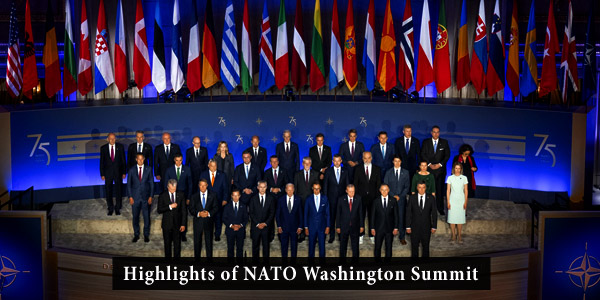
The NATO Summit in Washington, held from July 9-11, 2024, brought together the Heads of State and Government from NATO member countries to discuss pressing global security issues. This year’s summit celebrates the 75th anniversary of the alliance and focuses on strengthening deterrence and defense capabilities, supporting Ukraine, and reinforcing partnerships globally.
U.S. President Joe Biden hosted the meeting as several world leaders participated in this year’s summit, including, French President Emmanuel Macron, German Chancellor Olaf Scholz, and outgoing NATO Secretary General Jens Stoltenberg. Newly elected British Prime Minister Keir Starmer also made his maiden appearance on the international stage during the summit with a strong signal of support for Ukraine.
Key leaders from NATO partner countries across Europe and the Indo-Pacific region also attended the summit. However, these partners are not eligible for NATO membership under Article 10 of the NATO treaty, which restricts new members to European nations.
Attendees from partner countries included:
- Ukrainian President Volodymyr Zelenskyy
- Prime Minister Fumio Kishida of Japan
- Australian Prime Minister Anthony Albanese
- President Yoon Suk-yeol of South Korea
- New Zealand Prime Minister Christopher Luxon
- European Union leaders, including Charles Michel, President of the European Council, and Ursula von der Leyen, President of the European Commission
Foreign and defense ministers from several other countries also participated in the NATO Washington Summit.
Key Focus and Agenda
Washington Declaration
In the official declaration signed during the summit, the leaders emphasized NATO’s defensive nature and the enduring transatlantic bond, underpinned by shared values such as individual liberty, democracy, and the rule of law. NATO’s core tasks of deterrence and defense, crisis management, and cooperative security were highlighted as pivotal to maintaining peace and stability.
Sweden’s accession as NATO’s 32nd member, along with Finland, was celebrated, reinforcing the Alliance’s strength in the High North and Baltic Sea. The leaders underscored the significance of NATO’s Open Door Policy, affirming each nation’s right to choose its security arrangements.
Russia’s invasion of Ukraine was condemned as a significant threat to Euro-Atlantic stability, marking Russia as the most direct threat to Allied security. Terrorism was also identified as a direct asymmetric threat. Other global security concerns included strategic competition, instability in Africa and the Middle East, Iran’s destabilizing actions, and the coercive policies of the People’s Republic of China (PRC).Washington Summit Declaration issued by the Heads of State and Government participating in the meeting of the North Atlantic Council in Washington, D.C.#NATOSummit | #1NATO75years
— NATO (@NATO) July 10, 2024
The Summit marked steps to strengthen NATO’s deterrence and defense capabilities, bolster long-term support to Ukraine, and deepen partnerships. Notably, NATO’s commitment to defense spending was reaffirmed, with over two-thirds of Allies meeting the 2% GDP defense spending target. The Alliance’s largest military exercise in decades, Steadfast Defender 24, was announced to demonstrate readiness to defend any Ally under threat.
NATO’s reinforcement efforts include deploying combat-ready forces on the Eastern Flank, modernizing defense plans, enhancing deterrence and defense against all threats, and integrating new technologies. The establishment of the NATO Integrated Cyber Defense Centre and measures to protect critical undersea infrastructure were also highlighted. NATO’s air and missile defense capabilities were bolstered, including the deployment of the Aegis Ashore site in Poland.
Nuclear deterrence remains a cornerstone of NATO’s security strategy. The Alliance emphasized its commitment to arms control, disarmament, and non-proliferation while maintaining credible nuclear deterrence.
The Summit stressed the importance of transatlantic defense industrial cooperation, pledging to strengthen the defense industry across Europe and North America. National and collective resilience were highlighted as essential for credible deterrence and defense, with a call for public-private cooperation and societal resilience.
The NATO leaders condemned Russia’s hybrid actions and cyber activities, reiterating that hybrid operations could invoke Article 5 of the Washington Treaty. The commitment to counter-terrorism was reinforced with updated policy guidelines and an action plan to enhance NATO’s role in fighting terrorism.
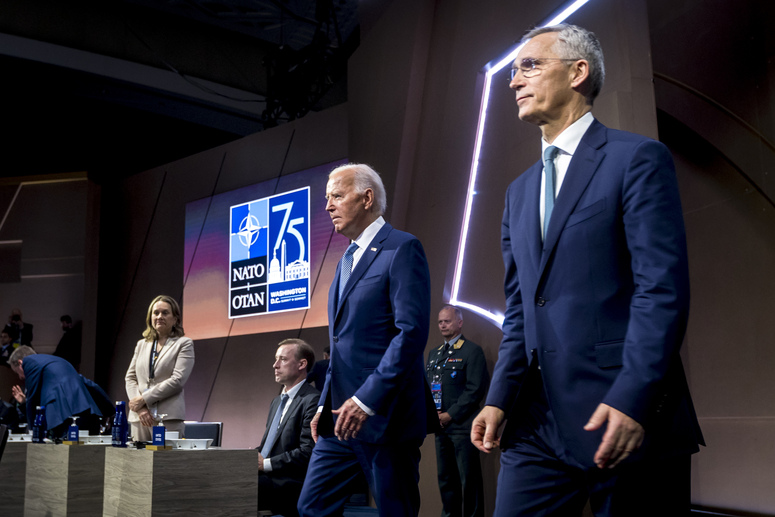 U.S. President Joe Biden with NATO Secretary General Jens Stoltenberg during the NATO Washington Summit meeting. (Image Credit: NATO)
U.S. President Joe Biden with NATO Secretary General Jens Stoltenberg during the NATO Washington Summit meeting. (Image Credit: NATO)Support for Ukraine remained a priority, with new initiatives like the NATO Security Assistance and Training for Ukraine (NSATU) to coordinate military equipment and training, and a Pledge of Long-Term Security Assistance. NATO-Ukraine cooperation was further strengthened with the establishment of the NATO-Ukraine Joint Analysis, Training, and Education Centre (JATEC).
NATO condemned Russia’s war of aggression and its violations of international law, calling for the immediate withdrawal of Russian forces from Ukraine. The Alliance expressed concern over Russia’s intensified aggressive actions and nuclear rhetoric, emphasizing the need for ongoing communication to mitigate risks and prevent escalation.
The PRC was criticized for supporting Russia’s war effort and posing systemic challenges to Euro-Atlantic security. NATO called on the PRC to cease support for Russia and uphold international responsibilities.
NATO’s partnerships were highlighted as key to enhancing global security and stability. Cooperation with the European Union reached unprecedented levels, and the Alliance committed to strengthening its strategic partnership with the EU. The importance of the Western Balkans and Black Sea regions for NATO’s security was reiterated, with continued support for reforms, regional peace, and countering malign influences.
Support for Ukraine and NATO Membership
The primary topic at the NATO summit is support for Ukraine. In a White House briefing preceding the summit, Biden’s security adviser, Mike Carpenter, told the reports that NATO allies had announced new support for Ukraine. This included renewed funding of $43.2 billion over the coming year, in addition to millions pledged bilaterally by NATO countries.
NATO Allies also unveiled the launch of a military command station in Germany aimed at bolstering Ukrainian forces with training and equipment. The command will have about 700 personnel from NATO countries and partner nations. It will facilitate equipment logistics and provide support to Ukraine’s armed forces through the command center and make Ukrainian force more interoperable with NATO military.
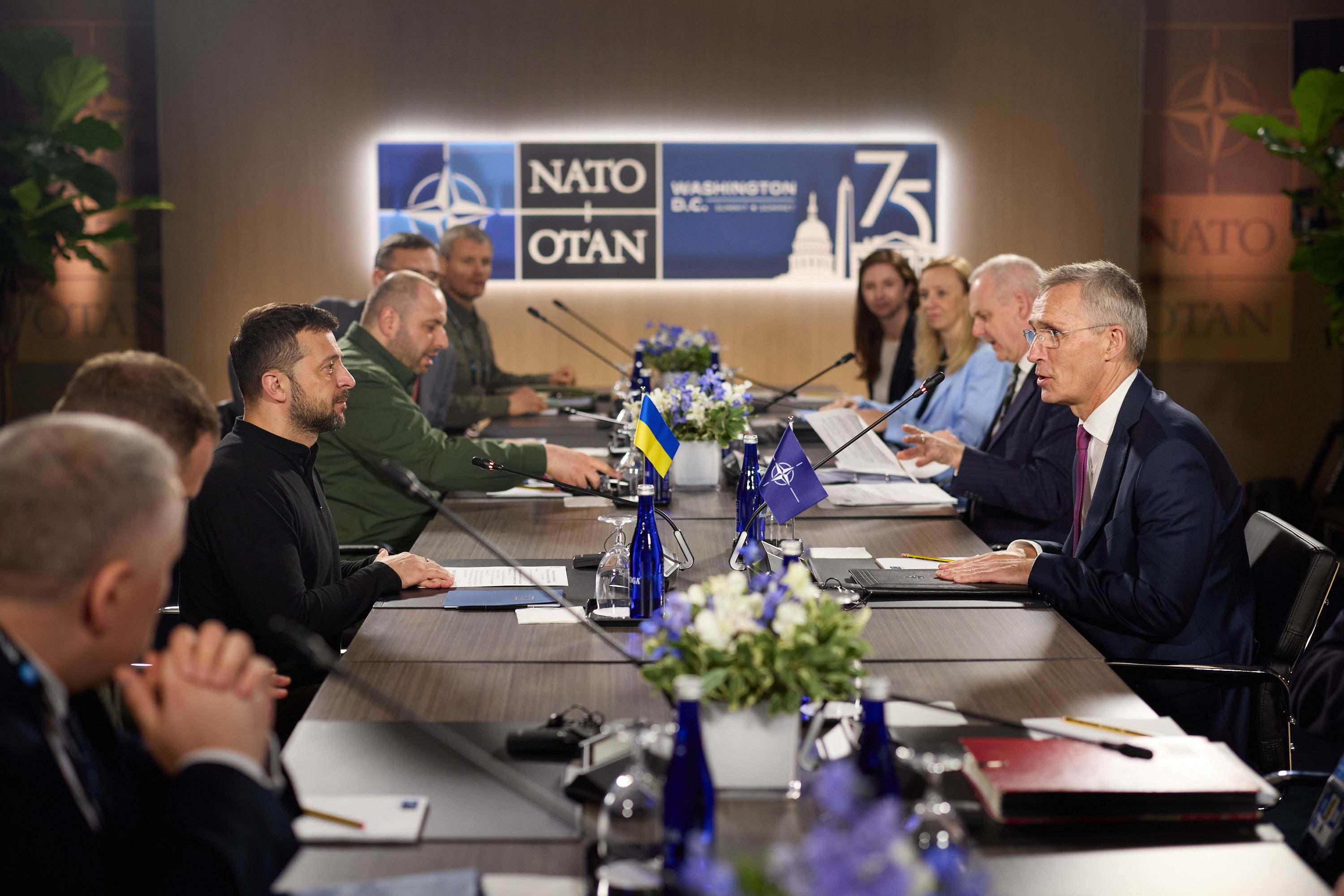 Ukraine’s President Volodymyr Zelenskyy attended the meeting with NATO Secretary General Jens Stoltenberg on the sidelines of the NATO Washington Summit. (Image Credit: X/@ZelenskyyUa)
Ukraine’s President Volodymyr Zelenskyy attended the meeting with NATO Secretary General Jens Stoltenberg on the sidelines of the NATO Washington Summit. (Image Credit: X/@ZelenskyyUa)Ukraine’s ambitions to join the NATO alliance, however, remain hindered by internal reform requirements and the alliance’s concerns about escalating tensions with Russia. NATO leaders, including Biden, had previously promised not to involve the alliance directly in the Russia-Ukraine conflict and had restricted Ukraine from using weapons provided by its allies on targets inside Russia.
Several NATO partners, including Biden, pledged to provide Ukraine with five new military equipment. The U.S. would provide strategic air defense systems to Kyiv for countering relentless Russian attacks, President Biden announced during the speech welcoming NATO leaders to Washington.
In his opening remarks at the summit, Biden declared the military alliance “more powerful than ever” as it faced a “pivotal moment” in the Russia-Ukraine war. Biden stated that the U.S. would partner with Germany, Italy, the Netherlands, and Romania to donate Patriot missile batteries and other systems to aid Ukraine, amid growing civilian casualties. “The war will end with Ukraine remaining a free and independent country,” Biden affirmed. “Russia will not prevail. Ukraine will prevail.”
NATO Allies unveiled plans to donate five strategic air defense systems and dozens of smaller anti-air batteries over the next year. President Volodymyr Zelensky had long pleaded for increased air defense supplies from Western allies. Biden’s speech, lasting 13 minutes, sought to reassure both international allies and domestic audiences of his capability to lead, despite skepticism about his future. The White House credited Biden’s leadership for NATO’s expansion, with Finland and Sweden joining the alliance since Russia’s invasion of Ukraine.
At the #NATOSummit, Allies have taken decisions to ensure support to Ukraine for the long haul#StandWithUkraine 🇺🇦 pic.twitter.com/bMYCYVFP3C
— NATO (@NATO) July 11, 2024
Defense Spending
The U.S., as NATO’s primary financial contributor, has long encouraged increased military spending from other member countries. Progress on the 2014 target for each country to spend at least 2 percent of its gross domestic product (GDP) on defense by 2024 remained a point of focus during the summit’s opening session.
According to a statement released by the White House, “the Alliance is spending more than ever on critical new defense procurement as well as research and development.” The statement further added that Increased defense spending must be paired with a robust transatlantic defense industrial base to ensure that Allies can produce and sustain critical munitions.
In Vilnius last year, the Allies adopted a Defense Production Action Plan aimed at connecting defense industries with defense planning, facilitating joint procurement, and making it easier for Allies to acquire the equipment needed to meet NATO’s capability targets and standards.
At the Washington Summit, the Allies took further steps to enhance cooperation and boost defense industrial production. This includes a pledge to coordinate national plans to improve industrial capacity, enhance standardization to promote interoperability and interchangeability, and strengthen demand signals to industry, ensuring these increased investments will continue over time.
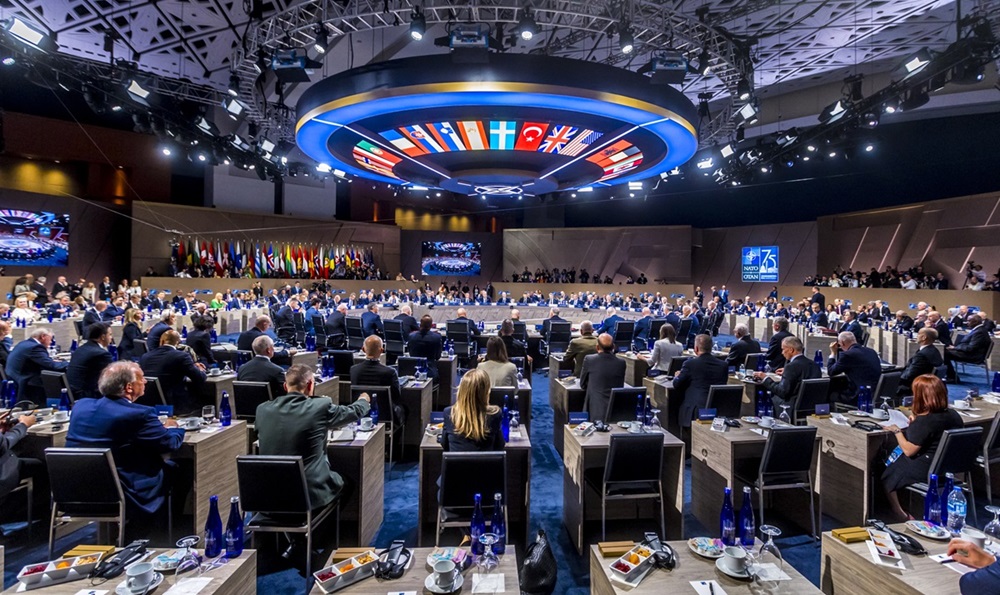 Meeting of the North Atlantic Council at the level of Heads of State and Government. (Image Credit: NATO)
Meeting of the North Atlantic Council at the level of Heads of State and Government. (Image Credit: NATO)NATO Allies also signed a $700 million contract with the U.S.-based defense giant, Raytheon, to produce more Stinger missiles and various pledges to enhance national defense capabilities. These announcements were made at the commencement of the NATO summit in Washington, highlighting the alliance’s focus on supporting Ukraine and preparing for future threats.
China-Russia Ties
U.S. and NATO officials have consistently highlighted the growing ties between Russia and China, emphasizing Beijing’s exports to Moscow of dual-use goods that support Russia’s war efforts in Ukraine. China’s role in the context of the Ukraine war as well as its increasing influence in the Indo-Pacific region remains a main point of focus for NATO leadership.
Outgoing NATO Secretary-General Jens Stoltenberg remarked in Washington before the summit, “Beijing is sharing high-end technologies like semiconductors and other dual-use items. Last year, Russia imported 90% of its microelectronics from China, used to produce missiles, tanks, and aircraft. China is also working to provide Russia with improved satellite capability and imagery. All of this enables Moscow to inflict more deaths and destruction on Ukraine, bolster Russia’s defense industrial base, and evade the impact of sanctions and export controls.”
U.S. Secretary of State Antony Blinken said last week at the Brookings Institution, “Increasingly, partners in Europe see challenges halfway around the world in Asia as being relevant to them, just as partners in Asia see challenges halfway around the world in Europe as being relevant to them.”
America’s top diplomat emphasized the U.S. efforts to bridge gaps between European alliances, Asian coalitions, and global partners. “That’s part of the new landscape, the new geometry that we’ve put in place.” White House national security adviser Jake Sullivan announced that NATO allies and Indo-Pacific partners would launch four new joint projects focusing on Ukraine, artificial intelligence, disinformation, and cybersecurity.
“Each initiative is different, but the main goal is the same: harness the unique strengths of highly capable democracies to address shared challenges,” Sullivan stated at a defense industry forum. As competition intensifies between the U.S. and China, countries with shared security concerns are strengthening ties, with Washington aiming to curb Beijing’s ambitions to challenge the U.S.-led world order, which China dismisses as a Cold War mentality. China, concerned by NATO’s increasing interest beyond Europe and the Western Hemisphere, closely monitored the summit and warned ASEAN and Asian nations of NATO's agendas.We discussed with NATO Allies and Indo-Pacific partners our common security challenges. Our security is interconnected.
— Josep Borrell Fontelles (@JosepBorrellF) July 11, 2024
China’s no limits partnership with Russia and DPRK’s military support fuel the Russia-Ukraine war of aggression against Ukraine and undermine the UN Charter. pic.twitter.com/bti0mSEEJY
NATO’s Future
In many respects, NATO appears stronger than ever. Since the Russian invasion of Ukraine, the alliance has expanded, adding two new members and bringing the total to 32. Additionally, Eastern and Central European members, such as the Baltic states, Poland, and the Czech Republic, have increased their support for Ukraine and NATO as an institution.
However, NATO remains fragile, as its policies require unanimous consensus, and political upheaval in member countries can impede decision-making. While NATO leaders reaffirmed their “open door” policy, which states that membership is available to any country meeting the requirements, Ukraine is unlikely to receive the invitation any time soon.
ALSO READ:
Regions
Issues

















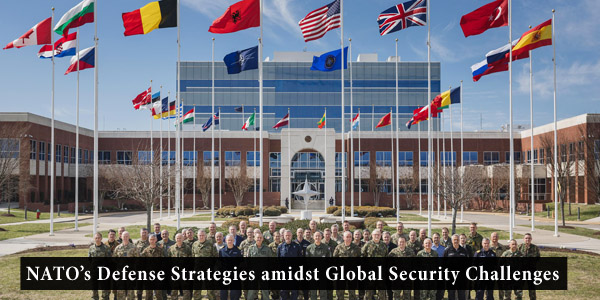 Analyzing NATO’s Deterrence and Defense Strategies amidst Global Security Challenges
Analyzing NATO’s Deterrence and Defense Strategies amidst Global Security Challenges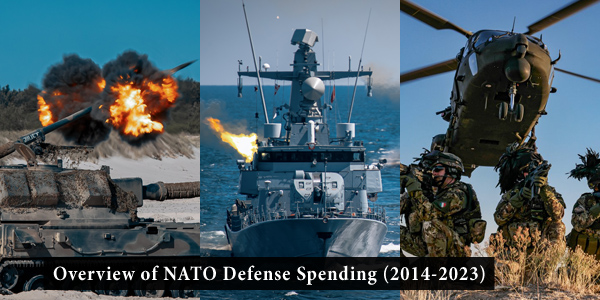 North Atlantic Treaty Organization Defense Expenditures from 2014 to 2023
North Atlantic Treaty Organization Defense Expenditures from 2014 to 2023







